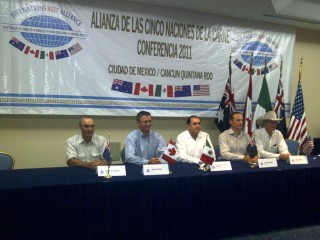 AS environmental and welfare groups ramp-up pressure on livestock producers to justify their use of natural resources and animals, industry leaders are grappling with the question of how extensively to engage with their antagonists.
AS environmental and welfare groups ramp-up pressure on livestock producers to justify their use of natural resources and animals, industry leaders are grappling with the question of how extensively to engage with their antagonists.
Simply ignoring them is not a long-term solution, but nor is being tied-down to unrealistic demands or blunt policy instruments that render food production unviable.
The question triggered significant debate at the Five Nations beef conference in Mexico late last month, where Cattle Council of Australia representatives met with their counterparts from the US, Canada, New Zealand and the host nation.
CCA executive director David Inall said that while all five countries were fierce competitors on the export stage, they also shared a strong spirit of cooperation in dealing with common threats and opportunities for their industry.
How closely industry leaders should engage with non-government organisations that take an alternative view of animal agriculture such as Animals Australia, the RSPCA, PETA, the World Wildlife Fund and Greenpeace was a subject of robust discussion at the recent conference, Mr Inall said.
“There are a range of views as to how close you should get with these organisations, and with the global round table for sustainable beef, there are differing views out there about engaging with organisations like the World Wildlife Fund,” he said.
“Certainly the Australian contingent remained firm that until there is a reason not to engage with those groups, then we will select a group that we want to engage with and that is what we will do.”
The World Wildlife Fund recently initiated roundtable discussions with key players in the global beef value chain including Cargill, JBS, McDonalds, Intervet Schering/Plough and Walmart.
The global discussions are focused on finding ways to not only feed a projected population of 9 billion people by 2050, but doing so with less farmland, with fewer and more precise inputs, and in a way that satisfies increasing environmental and animal welfare scrutiny.
Mr Inall said discussions involved issues such as managing ground cover, and how extension activities can be developed to espouse the economic and environmental benefits of maintaining adequate groundcover to producers.
He said CCA's view was that it was better to be at the table and working with environmental and animal rights groups to develop acceptable solutions than to have groups demanding harsh, blunt policy responses from Government.
“We think it’s better to have groups like WWF involved in the construct of it, but led by us,” Mr Inall said.
It was also critical that industry groups not just talk about making improvements in response to changing community attitudes about farming, but to also act on those commitments.
“We have to make sure that what we say we are doing we are actually doing,” he said.
“It is incumbent on organisations around the world like Cattle Council to work through member organisations and to use research and development to improve animal welfare and environmental practices, and to do things more efficiently.”
He said CCA’s counterparts in North America were pursuing a path of less direct engagement with NGOs and were instead working on promoting the industry’s sustainability credentials directly to the wider community.
"It is critically important for the Australian beef industry to meet or exceed consumer demands. We will work with those organisations who wish to constructively engage with industry with the shared goal of ensuring the consumer is satisfied with the manner in which beef is produced in Australia.”
US SPOTLIGHT ON TRACEABILITY
Traceability was also on the menu at the five nation’s beef conference in Mexico late last month, where Australia’s National Livestock Identification System was endorsed as a global leader.
In a sign of the increasing attention being paid to traceability in the US, American cattle industry leaders had requested that animal identification be added to the agenda of this year’s Five Nation’s conference.
Representatives of the five member countries were each asked to give presentations on where their respective nations were at with individual animal identification systems. Mr Inall said Australia’s NLIS system was acknowledged as a model for others to follow.
Discussions indicated that traceability was gaining increasing attention in Northern America.
“We have groups in Australia that like to think it is never going to happen in America,” Mr Inall said.
“And whether it happens as a single mandated scheme like we have is yet to be seen, but you can rest assured that it is well truly back on their radar again.
“Certainly from the producer organisation they have a high level of ambition about getting some form of nationally-consistent electronic traceability system.
“They obviously had a difficult time following their three cases of BSE. It was quite difficult for them to trace cohorts, and I think they have been scarred by that and it has taken so long for them to return to their key export markets like Japan and Korea."



HAVE YOUR SAY